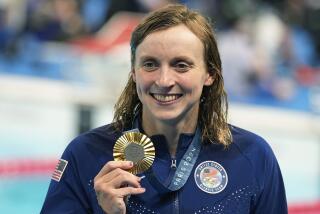Ann Curtis dies at 86; U.S. swimmer won three medals at ’48 Olympics
- Share via
Ann Curtis, who emerged as one of the country’s greatest female swimmers in the 1940s and won two gold medals and one silver medal in freestyle events at the 1948 Olympics, has died. She was 86.
Curtis died June 26 at her home in San Rafael, north of San Francisco, from complications ofAlzheimer’s disease, said her daughter Carrie Cuneo.
A San Francisco native who was trained by famed swimming coach Charlie Sava, Curtis set a record by winning 34 national Amateur Athletic Union championships during her career from 1943 to 1948.
“The world has never seen a girl swimmer like this one,” Sava said at the 1943 national championships in Indianapolis.
In 1944, the 5-foot-10, 160-pound swimmer became the first woman and the first swimmer to receive the James E. Sullivan Award, which is given to the outstanding amateur athlete in the country.
Curtis, who enrolled as a freshman at UC Berkeley that year, was also named woman athlete of the year by an Associated Press poll of the country’s sports editors.
Because the Olympics were suspended during World War II, she was unable to compete in 1944.
By the time the Games resumed in London in 1948, Curtis had broken numerous world and national records.
In the 100-meter freestyle, the 22-year-old slipped slightly as she dove into the water and won a silver medal by finishing two-tenths of a second behind the winner.
But Curtis set an Olympic record and won the gold medal in the 400-meter freestyle. And she won her second gold medal swimming the anchor leg in a come-from-behind U.S. victory in the 4 x 100-meter freestyle relay.
Returning to San Francisco, Curtis and her Olympic teammates were given a ticker-tape parade down Market Street.
“Was it ever exciting!” she recalled in a 2008 interview with the San Francisco Chronicle. “I was lucky that the Games restarted at a time I was still competing. There were awfully good swimmers before my time, and it was too late for them.”
During her 1940s heyday, Curtis appeared on the covers of Collier’s, Newsweek and other national magazines. She also turned down an offer from MGM.
“She was a very modest person, and she deflected any praise,” her daughter said. “If anybody complimented her on her swimming, she would say, ‘I had a great coach.’ ”
Born in San Francisco on March 6, 1926, Curtis was taught to swim at a boarding school run by Ursuline nuns in Santa Rosa and began swimming competitively at age 11.
Three years later she began training with Sava at the Crystal Plunge in San Francisco.
Sava had her swim three miles a day six days a week, along with two Sundays a month. And to increase her strength, he had her swim while pulling weights and with her feet tied together.
“He was the first coach to use repetitive and intensive workouts,” Curtis told Splash magazine in 1999. “Up to that point, it was thought that a swimmer peaked if he or she worked too hard and would not be at his or her best for the actual competition.”
Curtis’ victorious return home after the Olympics included being given a key to the city and the keys to a new convertible — a gift that would make her a professional and unable to participate in amateur sporting events if she accepted it.
But, she told the San Francisco Chronicle in 2001, she was engaged to be married and “I didn’t think I could successfully train and be a wife, too, so I accepted the car.”
Curtis married Gordon Cuneo, whom she had met at UC Berkeley, in 1949. She traveled with the Aqua Follies in the ‘50s but quit because she didn’t like being away from her growing family.
In 1959, Curtis and her husband opened the Ann Curtis School of Swimming in San Rafael, where she coached a swim team for 25 years and a synchronized team for 12 years. Her swimming students included future Olympians Rick DeMont and Ben Wildman-Tobriner.
Curtis was inducted into the International Swimming Hall of Fame in 1966.
True to form, the modest Olympian kept her medals tucked away at home in a bedroom drawer for many years. But sometime in the ‘60s, her mother-in-law had them framed and put them up on the wall in Curtis’ swim school office.
“She would not have displayed them if not for her mother-in-law,” said Carrie Cuneo, who now manages the swim school and private swim club.
Curtis’ husband died in 2010; a son, Bill, died in 2008.
In addition to Carrie, Curtis is survived by another daughter, Susan Cuneo Starr; two sons, David and Brian; nine grandchildren; and four great-grandchildren.
More to Read
Start your day right
Sign up for Essential California for the L.A. Times biggest news, features and recommendations in your inbox six days a week.
You may occasionally receive promotional content from the Los Angeles Times.






